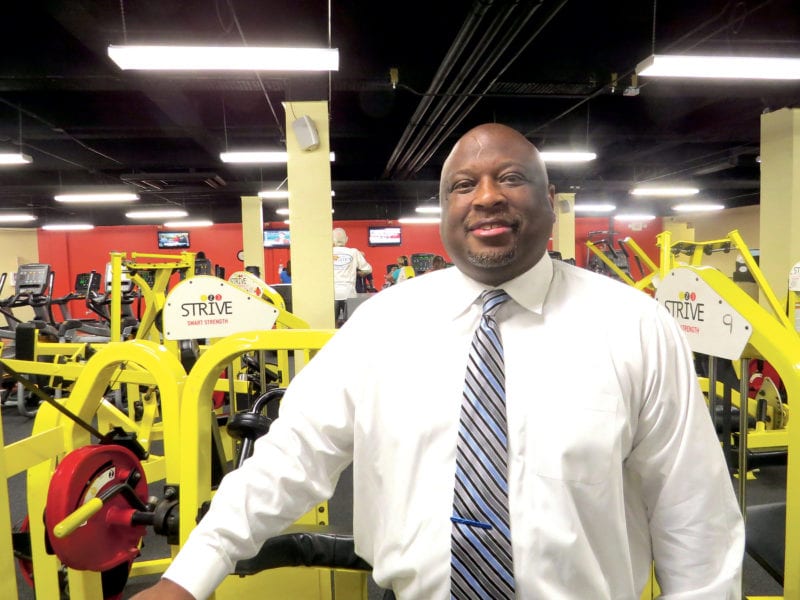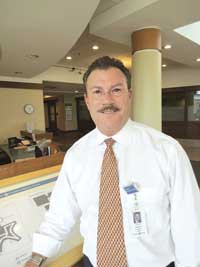Focused on Fiscal Fitness – Dexter Johnson Wants to Whip the Springfield Y into Shape
Last fall, while Dexter Johnson was making up his mind to take the job being offered him — president and CEO of the YMCA of Greater Springfield — a few friends and relatives had a simple five-word question for him: ‘Are you sure about this?”
He was — and is.
But he acknowledged then and now that those asking the question had every right to do so.
That’s because this YMCA, though steeped in history and tradition (it is the fourth oldest Y in the world, after all), like a number of other Ys across the country, has been struggling financially as it adjusts to a host of changes impacting the traditional Y business model, if you will.
These struggles are nothing new — they’ve been going on … well, for as long as most can remember. And a path to more-solid footing seems as elusive as ever.
But Johnson, who has been working for this YMCA for several years now and within the organization for more than two decades — and is therefore known as a ‘Y guy’ — decided that this was a challenge to embrace, not run away from.
And he’s never had any second thoughts.
But Johnson understands that the Springfield Y’s path to fiscal fitness will be challenging and, undoubtedly, lengthy. In short, some progress has been made, but there is still considerable work to do.
“This Y has operated with an operating deficit for a number of years now, “ he noted, adding that the organization has refinanced debt, tapped into its endowment, and taken other steps to cope with the red ink. “And we have to look at what our opportunities are to turn that around; our focus right now has been to get operations to a point where they’re approaching break-even status or creating a surplus. We’re doing better this year than we were last year, but we have a ways to go.”
The Springfield Y, like many others, has generally struggled in recent years due to a variety of factors, including changing demographics in urban centers and a proliferation of competition — there is seemingly a gym or two on every corner now.
But the difficult times have been exacerbated by some missteps, especially the opening of a branch in a strip mall in the center of Agawam. Attempting to duplicate the success of the Y’s Scantic Valley operation on Boston Road in Wilbraham, and armed with some data that said the venture could work (although there were some numbers that indicated otherwise) the center was opened in 2015.
But the ‘Y’ sign would come down only 18 months or so later, as the expected memberships never materialized.
“Looking back, that was just a mistake in judgment,” Johnson said. “After a year and a half of trying and making those efforts, we were losing significantly there to serve a really small population, so we decided to take the loss, which was painful, and move on.”
Moving forward, the Y will seek to avoid such mistakes and be more calculated in its attempts to be both entrepreneurial and fiscally prudent, said Johnson.
The biggest decision to be made will be with regards to its home on Chestnut Street. There are widespread and persistent rumors that the Y will be moving at least some of its operations into Tower Square in the heart of downtown Springfield. But when HCN pressed Johnson, he would say only that a number of options are still being considered, and that a decision would likely come at the end of this month.
The key, he told HCN, is to firmly identify the role this Y can play and must play in the years and decades to come. Not all YMCAs play the same role, he went on, especially given the demographic and societal changes taking place.
At the Springfield Y, for example, 60{06cf2b9696b159f874511d23dbc893eb1ac83014175ed30550cfff22781411e5} of all revenues come from child care, with the health and wellness components contributing only 30{06cf2b9696b159f874511d23dbc893eb1ac83014175ed30550cfff22781411e5}.
All this is explained, sort of, in new wording on the front of Johnson’s business card and in other marketing material used by the organization. Specifically, there are three new lines under the huge ‘Y’:
• For Youth Development;
• For Healthy Living; and
• For Social Responsibility.
Individual YMCAs can focus on one, two, or all three, he went on, but mostly, they have to mold themselves into what the region being served requires and what will ultimately work fiscally.
“The Y becomes what that community needs,” said Johnson. “If the community needs childcare and doesn’t need health and wellness, then we’re glad to provide that; or it could be health and wellness that goes well beyond treadmills.”
For this issue, HCN talked at length with Johnson about this process of becoming what the community needs while also putting the Y on more solid financial footing.
Sign of the Times
On the day he spoke with HCN, work crews were busy taking the old ‘Y’ logo off the side of the YMCA building on Chestnut St., a move undertaken in accordance with a national initiative to rebrand the institution and bring more consistency to the letter ‘Y’ used by individual YMCAs. A new sign will be going up “soon,” said Johnson.
“They give us color options, but there is a change in the logo,” he explained, noting that the new ‘Y’ (as in the letter on the letterhead) is more rounded in its look. “All the Ys throughout the country had kind of gone out on their own and come up with all kinds of different logos, and back in 2010 the national office said ‘enough’s enough, and we need to get back to being nationally identifiable.’”
There was more than a little symbolism attached to the exercise of taking the old ‘Y’ off the building. For starters, the Springfield Y missed the seven-year deadline to rebrand set by the national organization by a wide margin, an obvious symptom of its fiscal struggles. There’s also the poetic juxtaposition of giving the letter ‘Y’ a new look, while the staff and board and of the Springfield institution have been attempting to reinvigorate the local YMCA brand on a much broader scale.
And then, there’s the physical act of taking the letter off that building. Indeed, there are a number of questions about just how much longer the more-than-half-century-old structure will continue to serve in that capacity, and in what shape and form (much more on all that later).
Like we said, quite a bit of symbolism, and sorting it all out goes a long way toward explaining the challenges Johnson faces, but also the determination and passion he brings to his work.
And with that, we need to trace the steps that brought him to Springfield and his current assignment.
Our story starts in Tampa, Fla. That’s where Johnson attended a satellite campus of Springfield College, renowned for producing future YMCA leaders, and where he began amassing experience in virtually every facet of a YMCA operation, a diverse resume he believes is serving him well at this critical stage of his career. It’s also where he worked with Kirk Smith (he actually was Smith’s supervisor), who would eventually become director of the Springfield Y and convince Johnson to join him there.
“I was going to school to be a teacher and just went to the Y to work with some kids and get some experience, and 26 years later, I’m still here,” he said, noting that he started as director of the Child Care Services/Outreach program at the Tampa Metropolitan Area YMCA. He would later go on to direct the Youth Opportunity Movement program there and then become executive director.
After then serving as a district executive in Tampa and as a regional training manager at YMCA of the USA in Chicago, he joined Smith in Springfield as senior vice president and chief operating officer.
“I was ready to get back into the operational side of the Y and decided Springfield was the move,” he told HCN.
When Smith left for another opportunity in Florida, Johnson was named interim president and CEO, but the permanent job eventually went to Scott Berg, then associate vice president of Development at Springfield College and a key player in the opening of the Scantic Valley YMCA.
When Berg left less than two years later to become vice president of Philanthropy at Baystate Health, Johnson was quickly named his successor.
He takes over a Y that, as noted, is steeped in tradition (it dates back to 1852). But recent history has been marked by fiscal struggles and hard work to adapt to a changing landscape. And as Johnson addresses the many challenges facing him and the team he’s assembled, he plans to call on the many forms of experience he amassed.
“I definitely learned some valuable lessons during that time when I was interim president,” he noted. “But now that I’m in the permanent job, I’m definitely calling on all resources. During my time with Y USA I had the chance to make some great connections, and I have a number of CEOs and other leaders at Ys to give me counsel and help me through some of the challenges we have here.
“Nothing’s new when it comes to problems — they’ve all happened somewhere at some time before,” he went on. “So we’ll try to gain some advantage by learning from those experiences.”
Building Momentum
And an advantage will be helpful, because righting the fiscal ship has been an ongoing challenge, not just for this Y, but for facilities across the country, especially urban Ys; one in Pittsburgh recently filed for bankruptcy, said Johnson.
Specifically, the age-old challenge is generating revenues to meet and hopefully exceed expenses. In Springfield, the problem has been exacerbated by the downtown branch, an aging building that is expensive to maintain, and a facility that has seen its health and wellness membership numbers fall 40{06cf2b9696b159f874511d23dbc893eb1ac83014175ed30550cfff22781411e5} over the past decade.
Creating the Scantic Valley Y has helped the Y cope with the rising costs and falling revenues downtown, and the Agawam facility was conceived with similar ambitions; however it need did not match expectations.
Moving forward, the Y has to implement a long-term strategic plan for its downtown branch, and the operation as a whole, with the goal of making it become what the community needs.
Such a plan was drafted during Berg’s tenure, Johnson said, and, not surprisingly, its main focus was the downtown location — meaning both the building and the various programs housed there — and on devising actions plans for both.
As for the property itself, the Y sold the 40,000-square-foot residential component of it (the tower that faces Chestnut Street) to Home City Development, and still owns what’s left in what amounts to a condominium-like arrangement. But that portion it still owns is large, old, in many cases under-utilized, and in all cases expensive to operate and maintain.
Talk of a ‘new Y’ has been ongoing for years, said Johnson, noting that several of his predecessors have grappled with the issue and its myriad complexities, especially the cost of a new building.
Rumors have persisted, and one very preliminary proposal — to move to a closed car dealership site on Boston Road — made its way into the newspapers. “There’s still people that ask me … what happened to the Boston Road thing?” said Johnson.
Nothing happened with it, and nothing has really happened with any of the other rumored options, he went on, adding quickly, however, that the issue is real and a solution must eventually be found — and inevitably much closer to downtown than Boston Road.
At present — and on an ongoing basis — a variety of options are being looked at, he told HCN, including leasing space instead of owning it (the new owners of Tower Square have reached out, for example), extensively renovating the existing quarters, or eventually moving into much smaller, more efficient quarters.
“We probably have about 70,000 square feet, and we don’t need all that space quite frankly,” he said. “We have a whole racquet ball floor, and no one goes up there, really; if we decide to renovate and use this space, we would make it a smaller environment; 50,000 square would probably be more the right size to support the membership we have here.”
Building a new Y building is the long-term strategy, he said, adding that such a step would require significant fund-raising efforts and other steps. Shorter term, renting space might become an option, he went on, adding that there are pros and cons to any new location, temporary or permanent.
As for growing the Y, in terms of everything from its revenues to its presence within the community to its overall relevance, Johnson said the key, as it has always been, lies in partnerships with other groups and agencies across the city and the region.
“I’m looking to be a partner and be a part of any partnership that fits our mission, and that effectively serves this community,” he told HCN. “We’ve had some great partnerships with the Springfield Public Schools, the United Way, the Martin Luther King Family Center, and right now, we’re doing a multi-agency youth basketball league that is going gangbusters.
“To me, no agency can do it all,” he went on. “It has to be a collaborative effort, and I want to make sure that our Y is established as a strong community partner, whether that’s leading a collaboration or being a functional part of the collaboration.”





Comments are closed.